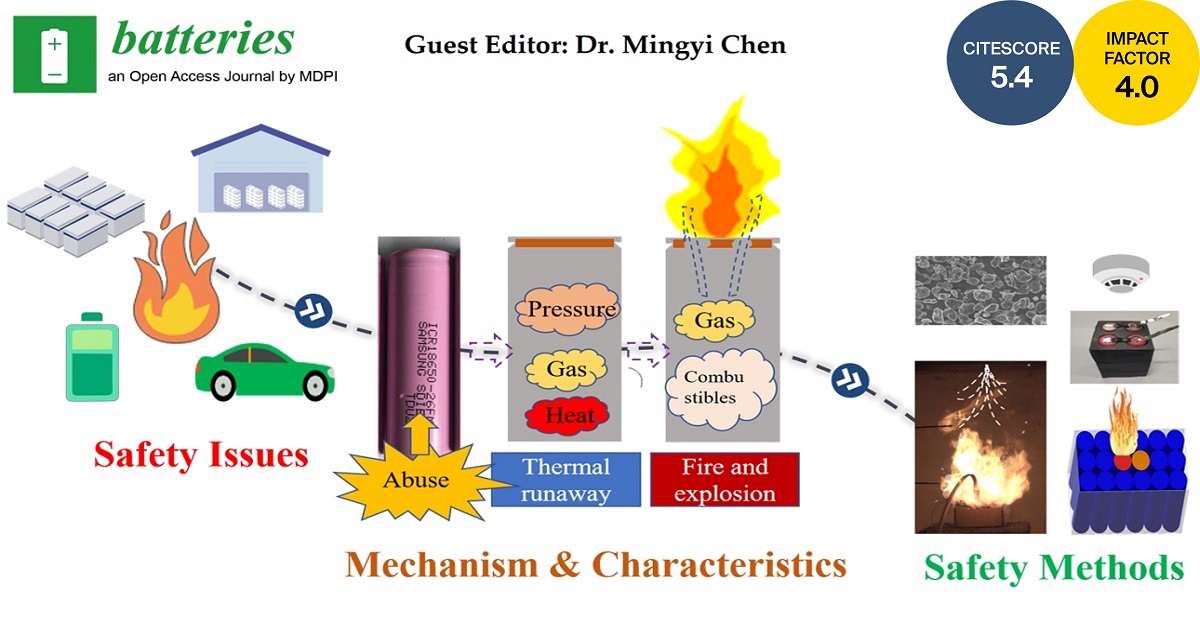Thermal Safety of Lithium Ion Batteries
A special issue of Batteries (ISSN 2313-0105). This special issue belongs to the section "Battery Performance, Ageing, Reliability and Safety".
Deadline for manuscript submissions: 20 June 2024 | Viewed by 18037

Special Issue Editor
Special Issue Information
Dear Colleagues,
At present, thermal safety issues, such as thermal runaway, fire, and the explosion of lithium-ion batteries (LIBs), have attracted public attention. Many accidents show that the thermal runaway of LIBs is currently the main cause of most fire and explosion accidents. On the other hand, the risk of the thermal runaway propagation of battery modules is high and the propagation speed is fast, which often causes serious loss of life and property, as well as adverse social impacts. Therefore, avoiding the thermal runaway of LIB modules and inhibiting the propagation of thermal runaway is an important requirement for the development of LIBs. In-depth research on thermal runaway risk management and control methods has important scientific significance and is also an international hot frontier.
This Special Issue will address the development of the thermal safety of LIBs. Topics of interest for publication include, but are not limited to:
- High-safety and high-performance battery design;
- The development of safety additive materials for LIB;
- Insights into thermal runaway mechanisms and thermal propagation mitigation;
- Safety tests (mechanical, electrical, thermal abuse);
- Degradation mechanisms and identification, elucidation, and diagnosis technology;
- Thermal management (liquid cooling, air cooling, phase change materials cooling, coupled cooling, etc.);
- Mechanism, characteristics, and propagation of battery thermal runaway, fire, and explosion;
- Risk assessment and optimal safety control and emergency management;
- The development, design, and utilization of detection and early-warning systems;
- Thermal runaway propagation, fire, and explosion suppression.
Dr. Mingyi Chen
Guest Editor
Manuscript Submission Information
Manuscripts should be submitted online at www.mdpi.com by registering and logging in to this website. Once you are registered, click here to go to the submission form. Manuscripts can be submitted until the deadline. All submissions that pass pre-check are peer-reviewed. Accepted papers will be published continuously in the journal (as soon as accepted) and will be listed together on the special issue website. Research articles, review articles as well as short communications are invited. For planned papers, a title and short abstract (about 100 words) can be sent to the Editorial Office for announcement on this website.
Submitted manuscripts should not have been published previously, nor be under consideration for publication elsewhere (except conference proceedings papers). All manuscripts are thoroughly refereed through a single-blind peer-review process. A guide for authors and other relevant information for submission of manuscripts is available on the Instructions for Authors page. Batteries is an international peer-reviewed open access monthly journal published by MDPI.
Please visit the Instructions for Authors page before submitting a manuscript. The Article Processing Charge (APC) for publication in this open access journal is 2700 CHF (Swiss Francs). Submitted papers should be well formatted and use good English. Authors may use MDPI's English editing service prior to publication or during author revisions.
Keywords
- safety design
- safety materials
- thermal runaway mechanism
- safety tests
- degradation diagnosis
- thermal management
- thermal runaway propagation
- risk assessment
- early warning
- fire suppression





